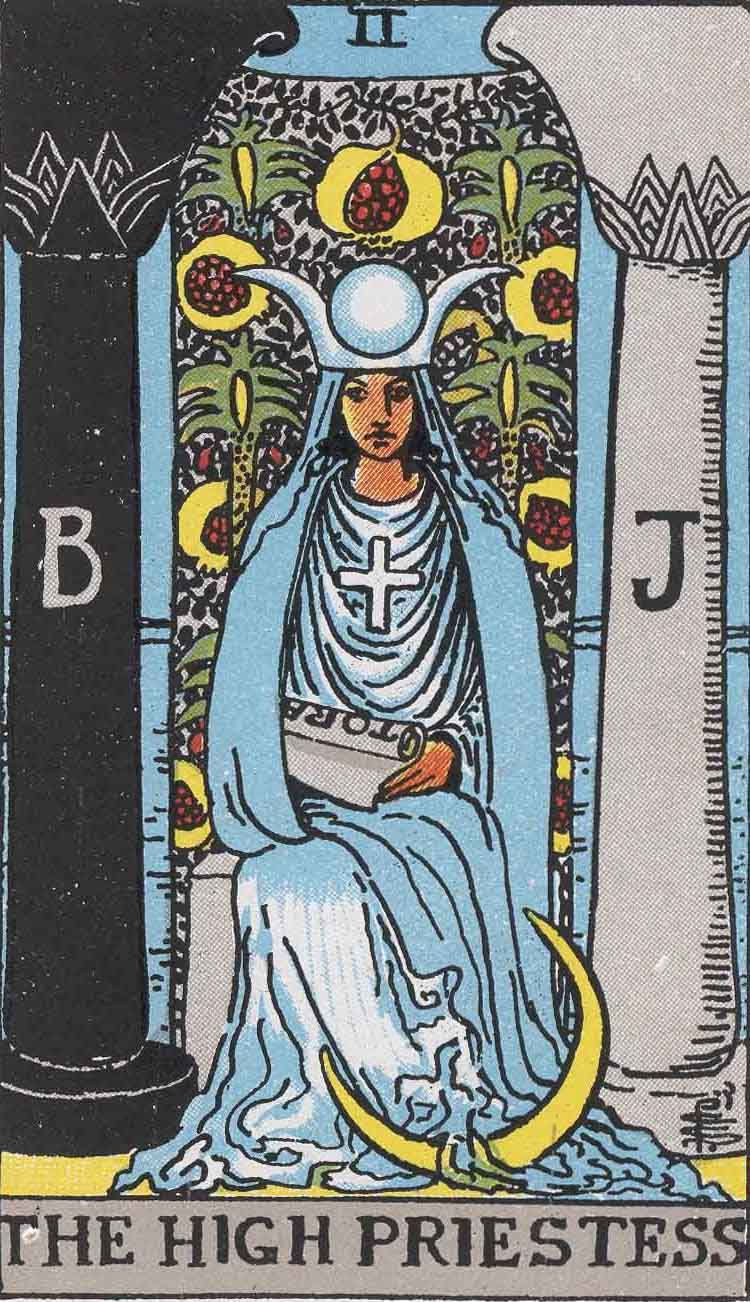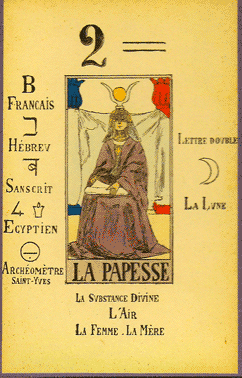Tarot Deep Dive - The High Priestess
- Dustin
- Mar 14, 2020
- 7 min read
Updated: Aug 8, 2020
In this series we are going to dive into the history of the imagery found in the tarot, the meaning of the card and how it changed over time, and the symbols present within what is arguably the most well known tarot deck of today - the Rider-Waite (Smith) Tarot Deck. So grab your favorite RWS based deck, a cup of tea or coffee, and join me live on Sunday mornings over on YouTube as we Deep Dive into each one of the 21 Major Arcana cards continuing with the enigmatic High Priestess.
The Popess, Pope Joan, La Papesse, Junon, The Priestess of the Silver Star

The archetype of the sacred feminine is common throughout much of the world. It was not until the rampant spread of Christianity that women's place in religion and their depictions in religious artworks subsided. Through much of the ancient world, women were not only worshiped and revered as creators of life, but also had exalted places within various ancient religions. The famed Oracle of Delphi, for example, was one such woman. As matriarchal traditions were replaced with patriarchal traditions we certainly see a dividing line of depictions of this archetypal character. Its even more interesting when we examine this archetype within the Tarot. In the earliest Tarot decks we find The High Priestess represented as The Popess or La Papesse. A woman, adorned with the triregnum, or Papal Tiara is very common in many traditional Marseilles style decks. It is thought that many depictions of this female pope is Pope Joan, who was an actual figure in history, elected to the papal office disguised as man, and it was not until Pope Joan actually gave birth that her actual gender was discovered. In what is considered to be one of the earliest and most complete decks we have access to, the Visconti Sforza Tarot, it is thought that the card represents Sister Manfreda, a nun of the Umilata order who was a relative of the family who commissioned the art of the deck and was elected Pope, In The Tarot Cards Painted by Bonifacio Bembo, Gertrude Moakley writes:
"Their leader, Guglielma of Bohemia, had died in Milan in 1281. The most enthusiastic of her followers believed that she was the incarnation of the Holy Spirit, sent to inaugurate the new age of the Spirit prophesied by Joachim of Flora. They believed that Guglielma would return to earth on the Feast of Pentecost in the year 1300, and that the male dominated Papacy would then pass away, yielding to a line of female Popes. In preparation for this event they elected Sister Manfreda the first of the Popesses, and several wealthy families of Lombardy provided at great cost the sacred vessels they expected her to use when she said Mass in Rome at the Church of Santa Maria Maggiore. Naturally, the Inquisition exterminated this new sect, and the "Popess" was burned at the stake in the autumn of 1300. Later the Inquisition proceeded against Matteo Visconti, the first Duke of Milan, for his very slight connections with the sect."
Although this association with Manfreda is widely accepted in most academic circles, including art historians, there is still some debate as to if the card within the Visconti Sforza Tarot is Manfreda or not. It is interesting to see then how this figure of the female pope, often regarded as heretical, evolved into the High Priestess card we know today. (For those more interested in this topic and association Mary K. Greer has an excellent write up which can be found on her blog here.
The meaning of the card reflects much of the change not only in societal perceptions of women in general, but a return to the occult pagan traditions in more modern decks that hold the sacred feminine in such high regard as the keepers of knowledge and history. Though, when you examine the meanings closely the idea of secrecy is prevalent through time; perhaps a nod to the secret Pope Joan had to keep in order to to raise so high with the church? Some of the cards meanings through time include:
De Mellet (1781): Pride, symbolized by her peacock. Idolatry.
Levi (1855): The Hebrew letter Beth, the female Pope. The house of God and Man, the sanctuary, the law, gnosis, Kabbala, the occult church, the duad, wife or mother.
Mathers (1888): The High Priestess. Science, wisdom, education.
Golden Dawn (1896): The Priestess of the Silver Star. High Prestess. Change, increase and decrease. Fluctuation (whether for good or evil is shown by cards connected with it.)
Waite (1910): The High Priestess. Secrets, mystery, the unrevealed future. The woman who interests the inquirer, if male; the inquirer herself, if female. Wisdom and science.
Crowley (1944): The card represents the most spiritual form of Isis the Eternal Virgin; the Artemis of the Greeks. She is clothed only in the luminous veil of light. It is important for high initiation to regard Light not as the perfect manifestation of the Eternal Spirit, but rather as the veil which hides that Spirit. It does so all the more effectively because of its incomparably dazzling brilliance. Thus she is light and the body of light. She is the truth behind the veil of light. She is the soul of light. Upon her knees is the bow of Artemis, which is also a musical instrument, for she is huntress, and hunts by enchantment.
The Embodiment of the Sacred Feminine
From the starkly Catholic heretical female pope, to the multi-faith depiction of the High Priestess we see today, this card represents the embodiment of the sacred and divine feminine within the Tarot's Major Arcana. Let us unravel the symbolism within the High Priestess found in the Rider Tarot Deck and see what secrets she guards.

The Symbols

The Pillars - Depictions of the two great pillars that stood outside of the historic Solomon's Temple, these two Pillars fundamentally represent all the aspects of duality that are required for creation. Labeled with the letters B and J respectively these are thought to stand for Beelzebub and Yahweh. Also possibly the initials of Boas and Jakim, corresponding to the eastern tradition of Yin and Yang. These two columns can be found in many esoteric traditions today including the Free Masons and the Golden Dawn, both societies of which Waite was a member of, and Smith was also a member of the Golden Dawn.

The Crown - Often associated with the Egyptian goddess Isis, the sister and wife of Osiris, and goddess of life, magic, and the revered goddess of many women in ancient Egyptian society. The crown is though to represent two crescent moons with the full moon in the middle, depicting the full lunar cycle, now often associated with the Maiden, Mother, and Crone in neo-paganism.

The Cross - The equal armed cross has a very long symbolic tradition associated with spirituality and religions. Placing this symbol on her chest tells us visually that these concepts are at the core of what the High Priestess is about. Sometimes used astrologically used to represent the planet Earth the equal armed cross also has a long standing tradition as a symbol of unification of male and female or other dual forces; mainly the ethereal and the material.

The Crescent Moon & Water - The moon and the oceans have long been associated with one and other due to the mysterious forces of the tides. Water, as we know from our Symbols in the Tarot Water discussion is associated with the unknown, our subconscious and our intuition. These meanings extend to the moon we find at the feet of our High Priestess which also represents these key mysteries in addition to associating this card to the long standing tradition of divine feminine associations with the moon. All of these can bee seen in the watery robe she is wearing, the vast ocean behind her veil, and the moon sat at her feet.

The Veil of Pomegranates & Palms - The veil behind the High Priestess hides the ocean, the great unknown. It is the dividing line between this world and the next. The pomegranate is usually thought to be associated with Persephone, Hades and the Underworld reflecting the death, life and rebirth cycle which are a main focus of the Eleusian Mysteries honoring Demeter and Persephone as the feminine source and symbolic representations of life. In I Old Testament, the pillars in the Temple of Solomon are said to have pomegranates above them, another tie to the sacred space. The Date Palm trees are often tied to the Egpytian goddess Hathor, who feeds the descended from the tree and represents the vital fluids of life.

The Scroll - One of the most widely debated symbols on the card, the simple scroll tucked under the arm of the High Priestess inscribed with the letters "TORA" is often thought to represent Hebrew Torah, the ancient holy books of the Jewish faith that comprise the first five books of the Old Testament of the Bible. Although many scholars have tried to decode the cryptic message left here that Waite does not seem to address in his writings. One of the first, Mathers, recombined the letters T-A-R-O in several permutations, connecting them to the essences of each the Major Arcana cards. Some even think it spells out TAROT, in the same way we see the letters represented on the Wheel of Fortune card later in the Major Arcana.
As always be sure to check out our live discussion on this very topic over on YouTube:
References:
Chang, T. Susan. Tarot Correspondences: Ancient Secrets for Everyday Readers. Llewellyn Pulbications, 2018.
Crowley, Aleister (aleister Crowley). Book of Thoth - (Egyptian Tarot). Red Wheel/Weiser, 2017.
Dean, Liz. The Ultimate Guide to Tarot: a Beginners Guide to the Cards, Spreads, and Revealing the Mystery of the Tarot. Fair Winds Press, 2015.
Fiebig, Johannes, and Evelin Burger. The Ultimate Guide to the Rider Waite Tarot. Llewellyn, 2013. Katz, Marcus. Secrets of the Waite-Smith Tarot: the True Story of the Worlds Most Popular Tarot: with Previously Unseen Photography & Text from Waite & Smith. Llewellyn Publications, 2015.
Moakley, Gertrude, and Bonifacio Bembo. The Tarot Cards: Painted by Bonifacio Bembo for the Visconti-Sforza Family an Iconographic and Historical Study. The New York Public Library, 1966.
Waite, A. E. Pictorial Key to the Tarot. Dover Publications Inc, 2005.
Wen, Benebell. Holistic Tarot. North Atlantic Books, 2015.
Images Sourced From: https://en.wikipedia.org/wiki/Wikipedia:Public_domain_image_resources













Comments